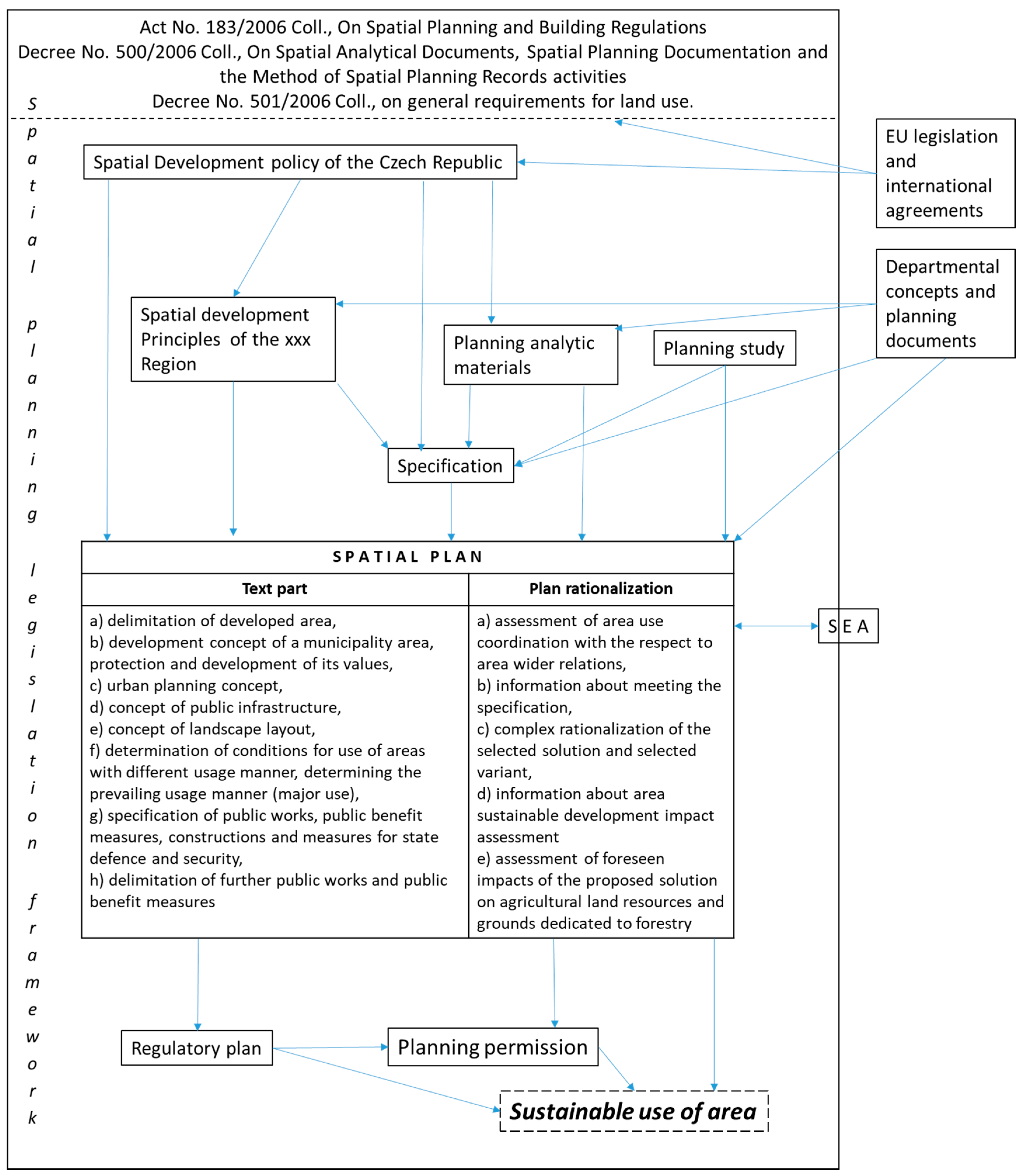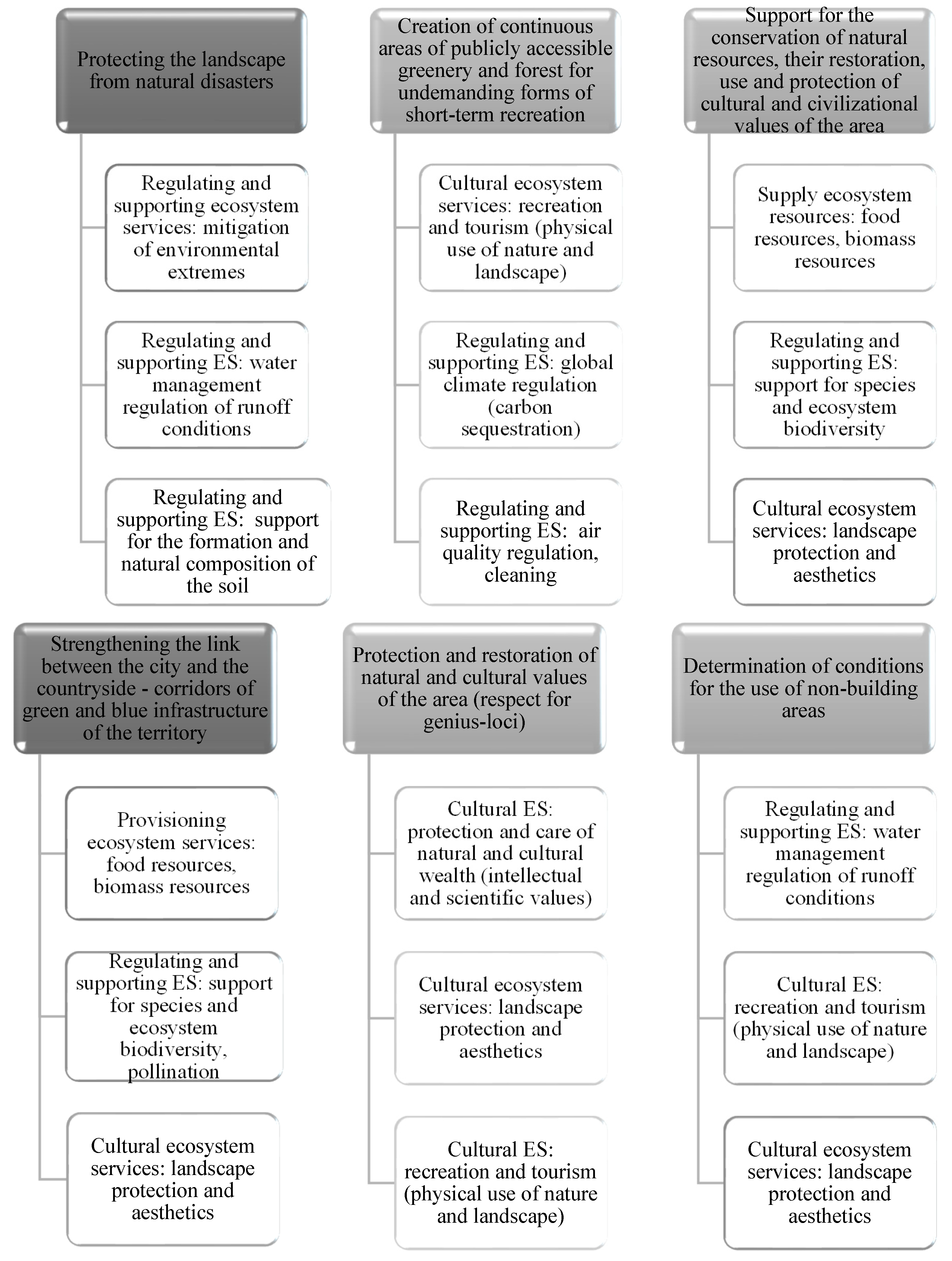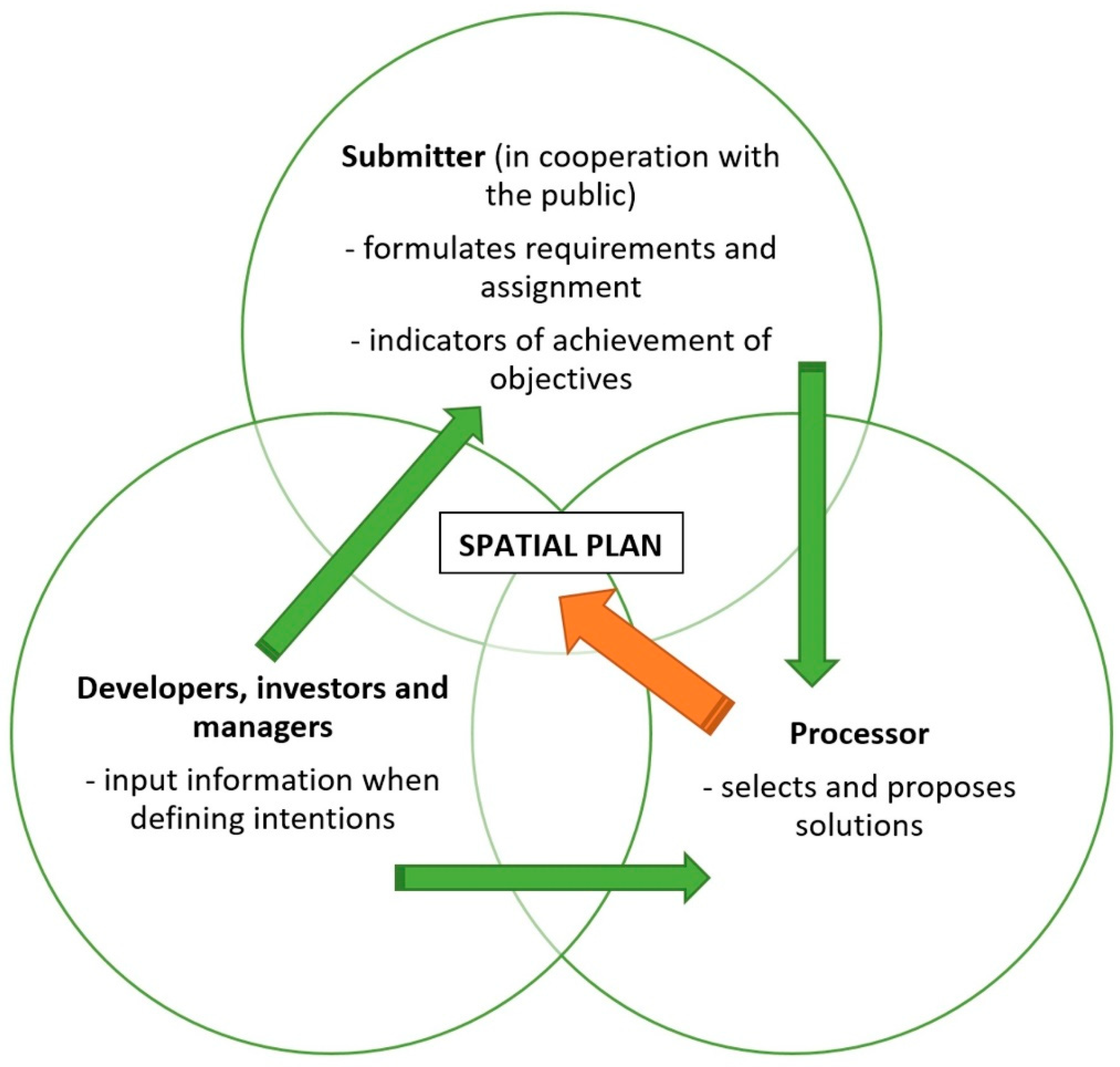Spatial planning tools (including spatial plans) in the Czech Republic have a structure fixed by legislation. This also affects the unified approach to the methods of elaboration of spatial plans, the character of which is therefore similar. This is a partial problem for the quality and creativity when creating spatial plans. Even with different requirements, given the specific conditions of individual cities, we will not find a progressive approach to processing documentation or solving problems. The findings can therefore be taken in a generalized way for the whole set of spatial plans and their proposals. The presented conclusions will apply to each of them.
3.1. How is the ES Concept, in Explicit and Implicit Terms, Represented in Spatial Plans?
We did not find an explicit expression of ecosystem services, or of the whole approach in the spatial plans of Czech cities. The terms “social functions”, “landscape functions”, “functions of green infrastructure”, or “non-production functions” are only rarely used. Non-productive functions are mainly associated with forest stands. This connection is given by the Forest Act, which uses the term “land intended for forest functions”. In addition, from the research point of view, this topic has the longest tradition in the Czech Republic and is the most developed. Implicitly, it is talked about in partial effects such as flood protection, recreation, or nature protection (see below). Overall, however, the link between spatial plans and ecosystem services is very weak.
3.2. To What Extent and Which ES Are Referred to within Spatial Plans and Their Chapters?
3.2.1. The Spatial Plan Assignment
The content of the Spatial Plan Assignment is the formulation of general and more specific requirements for each sub-chapter of the Spatial Plan. It is based on the current state of natural components and the current needs for the development of the city. They can be formulated clearly and comprehensibly, e.g., in the requirement, “ss part of the solution of the functional use of agricultural land, create favorable conditions for the development of livestock breeding for non-productive purposes, i.e., for recreation and leisure”. This requirement focuses on the production of ecosystem services, incorporates their philosophy, and does not need to be formulated within the ESA.
The main objectives of the assignment include keywords such as sustainable, environment, quality of life, reduction of environmental burdens, and protection and restoration of natural and landscape values, including watercourses-revitalization recreational potential. In addition to these, it also includes sustainable mobility, flexibility, and development areas as key points. It is therefore clear that the assignment aims to address environmental issues.
From the Assignments of the Brno and Liberec spatial plans, it is clear that spatial planning is focused primarily on the sources of ecosystem services (land use), and sometimes on the source of some prioritized ES (e.g., recreational greenery). Ecosystem services as a target for measurement (regardless of source) are not formulated anywhere. However, the assignment contains requirements for ensuring the use of ecosystem services, such as the permeability of the landscape for holidaymakers or the intention to declare a nature park or NATURA 2000 sites.
The functions of forests are mentioned only in general terms. They need to be protected and the recreational infrastructure needs to be addressed as much as possible. On the other hand, individual functions or ecosystem services of forests belong to forestry plans such as the Forest Management Plan or Regional plan of forests development in terms of planning.
When dealing with noise pollution, there are no requirements for noise reduction through ecosystem services, but rather the organization of transport and noise sources.
Air pollution is again primarily a solution (elimination of impacts) of sources of pollution. However, there is a requirement for “the highest possible share of green space in all development areas as a factor of a significant factor eliminating dust and improving air quality”.
Recreation and greenery is a separate chapter. It is divided into several articles. However, even here we will not find a more detailed use of ecosystem services:
Greenery as a part of all functional areas—the emphasis is mainly on green horizons and additional (unspecified) functions.
Urban greenery—the issue is conceived only as the design of new areas of parks, without functional concretization. However, this does not mean that the comments cannot be used in the actual design of the plan.
Suburban landscape—the concurrence of recreation and nature protection is respected here, no other ESs are listed.
Recreation areas—recreational potential and use is given more in general.
Allotment localities—existing ones in the assignment are perceived mostly negatively (they make the city impassable, individual recreation at the expense of the general one). On the other hand, they are accepted as a traditional form of leisure (the big boom in the 70s and 80s of the 20th century). The aim is the localization reorganization of allotment colonies—to propose a new use of areas with existing ones and to find a place for new allotment colonies.
The protection of ecosystem services resources is also required as a measure in the Geology subchapter—all risk or limiting factors resulting from geological and hydrogeological environmental conditions must be taken into account, and risks must be minimized in areas of threat to groundwater quality.
From the above analysis of the assignment, it is clear that the contracting authorities are not able to define ecosystem services and therefore not able to target them more precisely with their measures. Nevertheless, the production or provision of ecosystem services (not directly, but through their nominal expression) is generally ensured through awareness of the importance and protection of their resources.
Table 4 presents other individual mentions of target ecosystem services, as can be found in the Spatial Plan Assignment.
3.2.2. Text Part of Spatial Plan
The chapters of the text parts of the spatial plans, which should inherently address or at least touch on ecosystem services, are as follows:
Development concept of a municipality area, protection and development of its values
Urban planning concept
Concept of public infrastructure
Concept of landscape layout
Determination of conditions for use of areas with different usage manner, determining the prevailing usage manner (major use)
Specification of public works, public benefit measures
The text part of the spatial plans approaches the formulation of target services similarly to the assignment of spatial plans—i.e., it focuses primarily on the resources of ecosystem services and their protection. This is often implemented through technical measures (e.g., influencing runoff conditions as part of flood protection. In the case of water or forest areas, departmental/component legislative documents and plans express support for their ecosystem services (regional plans of forests development, plans of basin areas). Therefore, they are not specified in the spatial plans.
The ecosystem services of urban blue–green infrastructure (especially parks) are approached also implicitly.
Table 5 presents an overview of the use of ecosystem services in individual chapters of the text part of spatial plans of the cities of Brno, Hradec Králové, Olomouc, Plzeň, and Liberec.
3.2.3. Plan Rationalization
The content of plan rationalization explains the reasons for the implementation of the measures proposed in the text part. It is clear from the documents of all five cities that ecosystem services are not yet part of the interpretive methodology of plan rationalization. For example, the justification of the concept of landscape layout ÚPHK works with basic urban and landscape theories, presented on the specific spatial arrangement of the city of Hradec Králové.
The plan rationalization also includes the chapter, “Evaluation of meeting the requirements of the assignment”. The example of plan rationalization of the spatial plan proposal of Hradec Králové (ÚPHK) presents the level of evaluation.
Requirement: “Respect public interests in the field of protection of biological diversity and environmental quality, especially in the form of consistent protection of specially protected areas, NATURA 2000 sites, wetlands, water protection zones, protected areas of natural water accumulation and mineral wealth, protection of agricultural, and forest land fund. Create territorial conditions for the implementation and respect of territorial systems of ecological stability (TSES) and the maintenance and improvement of ecological stability and for ensuring the ecological functions of the landscape and for the protection of landscape elements of a natural character in built-up areas. Create conditions for the protection of the landscape with regard to the target characteristics and types of landscape and create conditions for the use of natural resources” (Plan rationalization of spatial plan proposal of Hradec Králové).
Evaluation: “Done. The concept of ÚPHK consistently respects all principles of nature, landscape, and water protection, as well as natural elements in the territory, including all territories and areas that are the subject of protection. ÚPHK specifies supra-regional and regional elements of TSES, defines elements of local TSES, and creates conditions for its establishment. ÚPHK further defines the conditions for the protection of the landscape. Segments with natural character in a built-up area are defined as separate areas of greenery (areas of public spaces) … ÚPHK respects and protects these areas as elements of fundamental compositional importance, which contribute to the diversity of the area and increase its ecological stability” (Plan rationalization of spatial plan proposal of Hradec Králové).
As is clear from the above cases, this assessment is rather formal and general, despite the fact that there is a space for the use of ecosystem services as indicators of the level of meeting the requirements of the assignment.
The individual ecosystem services, explicitly mentioned to justify the chosen solution, are listed in the subchapter, “Concept of landscape layout, delimitation of areas and determination of conditions for changes in their use, territorial system of ecological stability, permeability of the landscape, anti-erosion measures, protection against floods, recreation, mining, etc.”. The significance of individual types of green areas is described, for example, as follows: “Areas of urban greenery must be preserved or implemented to fulfill all their functions. These green areas co-create a favorable environment for the population, help maintain and create a suitable microclimate (dampen temperature fluctuations, increase humidity, capture precipitation, reduce noise and dust, have a positive effect on air quality), clearly create a pleasant environment for daily short-term recreation (e.g., babysitting, sports activities, the possibility of sitting for senior citizens, a meeting place and space for community activities of the population), and last but not least, have a positive effect on the human psyche” (Plan rationalization of the Plzeň spatial plan).
3.4. What Are the Possibilities for Innovation of Spatial Plans through Ecosystem Services?
The main tool in the creation of spatial plans, which will ensure the effective implementation of ecosystem services into spatial planning, is the assignment of a spatial plan. The existing legislative rules (Annex No. 6 to Decree No. 500/2006 Coll.) defining the structure of the Assignment allow this with their generality. However, this step cannot be approached in an uncoordinated manner; it is necessary to compare the detail of the ES’s inclusion in the Assignment with other measures, such as the detail of the explanation of the technical infrastructure. Ways in which individual groups of main participants in the creation of the Spatial Plan Assignment can use ESA in the process of preparing the spatial plan are presented in
Figure 4.
The text part of the spatial plan itself gives space for implementation, primarily in the approach. This means that if a society needs to define, for example, a new type of area or update one of the existing types of areas with the currently needed ecosystem service, it will also include it in the spatial plan. This also applies to the Assignment innovation. However, this mechanism is linked to the perception of societal values. Spatial planning is just a tool for their application.
Extending existing access to ecosystem services as an explanation of the measure is a logical step in plan rationalization. However, it is necessary to work with the entire ES group (e.g., according to TEEB), not just with a group of selected ones.
It is also logical to use it in assessing the impact of the implementation of the spatial plan on sustainable development and the environment (SEA). Once again, however, it is necessary to accept that it is not possible to innovate in detail only the environmental pillar of sustainable development without considering a uniform level of detail for the economic and social pillar (due to their interconnectedness).










